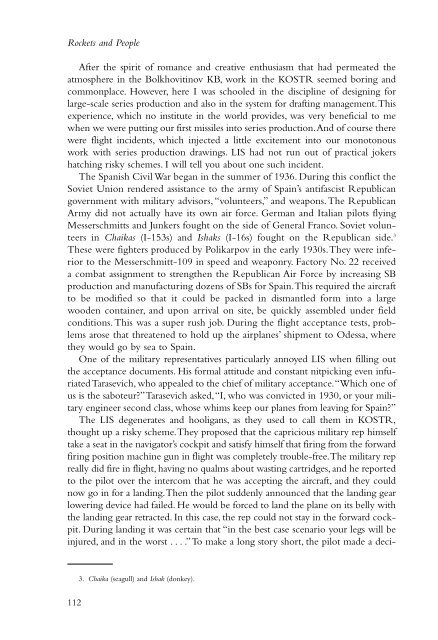to open next chapter. - NASA's History Office
to open next chapter. - NASA's History Office
to open next chapter. - NASA's History Office
Create successful ePaper yourself
Turn your PDF publications into a flip-book with our unique Google optimized e-Paper software.
Rockets and People<br />
After the spirit of romance and creative enthusiasm that had permeated the<br />
atmosphere in the Bolkhovitinov KB, work in the KOSTR seemed boring and<br />
commonplace. However, here I was schooled in the discipline of designing for<br />
large-scale series production and also in the system for drafting management.This<br />
experience, which no institute in the world provides, was very beneficial <strong>to</strong> me<br />
when we were putting our first missiles in<strong>to</strong> series production.And of course there<br />
were flight incidents, which injected a little excitement in<strong>to</strong> our mono<strong>to</strong>nous<br />
work with series production drawings. LIS had not run out of practical jokers<br />
hatching risky schemes. I will tell you about one such incident.<br />
The Spanish Civil War began in the summer of 1936. During this conflict the<br />
Soviet Union rendered assistance <strong>to</strong> the army of Spain’s antifascist Republican<br />
government with military advisors, “volunteers,” and weapons.The Republican<br />
Army did not actually have its own air force. German and Italian pilots flying<br />
Messerschmitts and Junkers fought on the side of General Franco. Soviet volunteers<br />
in Chaikas (I-153s) and Ishaks (I-16s) fought on the Republican side. 3<br />
These were fighters produced by Polikarpov in the early 1930s.They were inferior<br />
<strong>to</strong> the Messerschmitt-109 in speed and weaponry. Fac<strong>to</strong>ry No. 22 received<br />
a combat assignment <strong>to</strong> strengthen the Republican Air Force by increasing SB<br />
production and manufacturing dozens of SBs for Spain.This required the aircraft<br />
<strong>to</strong> be modified so that it could be packed in dismantled form in<strong>to</strong> a large<br />
wooden container, and upon arrival on site, be quickly assembled under field<br />
conditions. This was a super rush job. During the flight acceptance tests, problems<br />
arose that threatened <strong>to</strong> hold up the airplanes’ shipment <strong>to</strong> Odessa, where<br />
they would go by sea <strong>to</strong> Spain.<br />
One of the military representatives particularly annoyed LIS when filling out<br />
the acceptance documents. His formal attitude and constant nitpicking even infuriated<br />
Tarasevich, who appealed <strong>to</strong> the chief of military acceptance.“Which one of<br />
us is the saboteur?”Tarasevich asked,“I, who was convicted in 1930, or your military<br />
engineer second class, whose whims keep our planes from leaving for Spain?”<br />
The LIS degenerates and hooligans, as they used <strong>to</strong> call them in KOSTR,<br />
thought up a risky scheme.They proposed that the capricious military rep himself<br />
take a seat in the naviga<strong>to</strong>r’s cockpit and satisfy himself that firing from the forward<br />
firing position machine gun in flight was completely trouble-free.The military rep<br />
really did fire in flight, having no qualms about wasting cartridges, and he reported<br />
<strong>to</strong> the pilot over the intercom that he was accepting the aircraft, and they could<br />
now go in for a landing.Then the pilot suddenly announced that the landing gear<br />
lowering device had failed. He would be forced <strong>to</strong> land the plane on its belly with<br />
the landing gear retracted. In this case, the rep could not stay in the forward cockpit.<br />
During landing it was certain that “in the best case scenario your legs will be<br />
injured, and in the worst . . . .”To make a long s<strong>to</strong>ry short, the pilot made a deci-<br />
112<br />
3. Chaika (seagull) and Ishak (donkey).
















